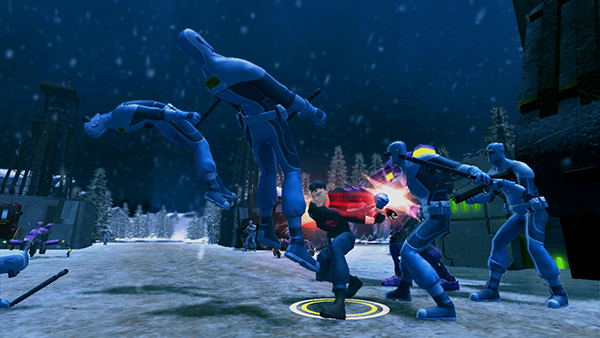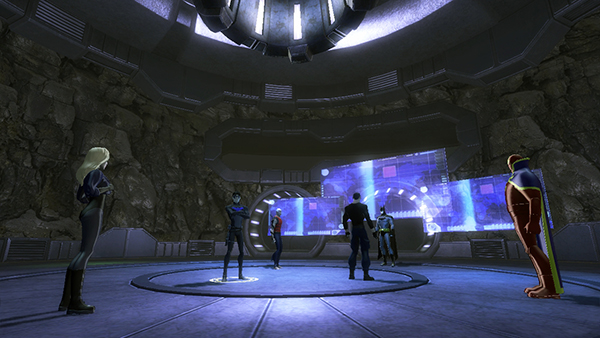

It’s an unfortunate fact of video game life: tie-in games are often very bad. Whether they are based on movies, TV shows, books, or comics, most games of this type are of substandard quality. Consider recent reviews of Adventure Time and Family Guy, for instance. But every once in a while, there are tie-ins that surprise you and end up being quite good, like Goldeneye or Spider-Man 2. So where should we place Young Justice: Legacy on the video game tie-in continuum? Is it good, bad, or somewhere in the middle?
I really, REALLY wanted this game to be good, or somewhere in the middle. On paper, Young Justice: Legacy has a lot going for it. It is based on a very good TV series featuring characters from the DC comics universe. It has three player local co-op, and would be perfect for playing along with my two kids, who are comic fans just like I am. The game is also obviously inspired by the X-Men Legends and Marvel Ultimate Alliance series of games, which I consider to be among the greatest games of their respective generations. But even with all these things in its favor, Young Justice: Legacy is a bad game, tie-in or otherwise.

The most obvious shortcoming is the game’s graphics. The entire game looks as if it was released for the Playstation 2. The heroes are poorly rendered, with gangly limbs and bizarre proportions. If the developers were going for an “awkward teenage phase” look to the Young Justice crew, they totally succeeded. Environments, from generic jungles to off the shelf building interiors, are bland and repetitive. Even super power attacks, which should be a highlight, have boring animations. Worst of all are the cut scenes, which show, up close and personal, exactly how poor the graphic quality is.
Though the graphics in Young Justice: Legacy are bad, I am a firm believer that gameplay trumps graphics every time. Unfortunately, the game is lacking in this area as well. The formula for action RPGs is quite standard by now: you move a character around, beat up, shoot or otherwise incapacitate a bunch of enemies, and upgrade your abilities, then do it all again. The genre can be repetitive if not handled correctly. Young Justice: Legacy doesn’t handle it correctly. Special abilities are wildly unbalanced, ranging from ineffective to screen clearing. Standard enemies don’t pose any challenge or call for any unusual tactics. Boss fights range from laughably easy to teeth-grindingly hard. There is no compelling reason to earn upgrades, and no loot gathering motivating you to continue. All of the little bread crumbs that keep you playing a good action RPG are missing. Instead you are left with repetition and tedium.

Levels are quite large, which is usually a good thing, but often you will run along a path for several minutes without encountering any enemies. These paths appear to have no other purpose than to artificially extend the length of the game. When enemies do appear, they come in large bunches of nearly identical models. Occasionally, you will have to clear a room in order to open a door and move on. Often, there is a lone enemy standing motionless in the corner or behind an object that you have hunt down in order to continue. This kind of thing happens all the time. Level design is poor and enemy behavior is nonsensical. Again, Young Justice: Legacy feels like a title that should have been released a decade ago.
So, how are the cooperative elements? You would expect a game based on a superhero group to have strong elements of teamwork. Co-op in Young Justice: Legacy is a mixed bag. Up to three players can play locally, which is better than the co-op minimum of two. Additional players can drop in or out at any time, which is always a nice feature. Online co-op is supported. Players can easily revive one another in order to get back into the fight. A “teamwork move” is included in the form of Squad Boost. When all three teammates fill their respective boost bars, you can perform a Squad Boost, which does a burst of damage and also powers up the team briefly. It’s not nearly as impressive as the fusion attacks in Marvel Ultimate Alliance 2, for instance, but at least there is something there to alleviate the tedium a little bit.
I’ve been quite negative so far, and justifiably so, but Young Justice: Legacy does have some good qualities. The voice acting is excellent, featuring the same actors as the TV series. The story of the game takes place between season 1 and 2 of the show, and fills in some of the blanks from this time period in the team’s history. The developers clearly loaded this game with content for fans of the show, and in this respect, they did a great job. The superb voice acting and canonical storyline stand in stark contrast to the game’s other shortcomings.
In the end, your enjoyment of Young Justice: Legacy is going to come down to your affection for the TV show itself. If you are a big fan of the characters and are hungry for details about what happened during this time in the team’s history, you will likely find enough of that here to make the game enjoyable for you. If you are simply looking for a good video game experience, though, you will not find it here. Go play through Diablo 3 or Marvel Ultimate Alliance again instead. Young Justice: Legacy is one more piece of evidence for the “tie-in games are always bad” argument. Even super heroes couldn’t save this one.
This review is based on the Xbox 360 version of the game, a copy of which was provided by the publisher.